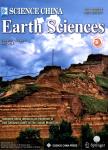Climate variability recorded by n-alkanes of paleolake sediment in Qaidam Basin on the northeast Tibetan Plateau in late MIS3
Climate variability recorded by n-alkanes of paleolake sediment in Qaidam Basin on the northeast Tibetan Plateau in late MIS3作者机构:State Key Laboratory of Lake Science and EnvironmentNanjing Institute of Geography and LimnologyChinese Academy of SciencesNanjing 210008China Graduate University of Chinese Academy of SciencesBeijing 100049China Key Laboratory of Boyang LakeMOESchool of Environmental and Chemical EngineeringNanchang UniversityNanchang 330031China
出 版 物:《Science China Earth Sciences》 (中国科学(地球科学英文版))
年 卷 期:2010年第53卷第6期
页 面:863-870页
核心收录:
基 金:supported by National Natural Science Foundation of China (Grant Nos. 40871096 40371117)
主 题:paleolake sediment molecular fossil n-alkane paleoclimate paleoenvironment solar insolation
摘 要:Here we combine n-alkanes preserved in a shell bar section from Qarhan paleolake, Qaidam Basin with the other sedimentary proxies to elucidate the lake evolution process during the period 39.7 to 17.5 14C ka BP (calibrated age ranges from 43.5 to 22.4 cal. ka BP). In different stages, the n-alkane homologues exhibited different distribution modes indicative of variations in the surrounding vegetation and the hydrologic condition of the lake. The n-alkanes proxies (CPIh, ACLh, Paq) have the same trends as the summer solar insolation variation, implying that the summer insolation is the most important climatic factor driving the environmental changes and also indirectly controls lake evolution on the Tibetan Plateau. CPIh and ACLh as well as the total pollen concentration appear to show a trend comparable with methane concentration record from the GRIP ice core that reflected the Dansgaard-Oeschger events. This demonstrates that the paleoclimate variations in Qarhan area generally agree with global climate change and show rapid oscillations in late MIS3. These findings provide the latest molecular fossil evidence from paleolake sediments to confirm that lake evolution on Tibetan Plateau in late MIS3 was closely associated with enhanced summer insolation.



